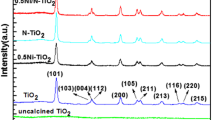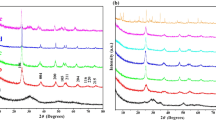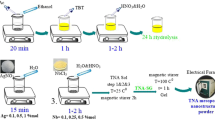Abstract
Mesoporous TiO2-xNx nanoparticles were synthesized by selective dissolving of Si in N-doped Ti-Si binary oxides, which were nitridized at 900 °C in a flow of ammonia gas, and the mesoporous TiO2-xNx photocatalysts were then modified by depositing Pt through a microwave polyol method. The samples were characterized by field emission scanning electron microscopy (FE-SEM), X-ray diffraction (XRD), Raman spectroscopy, transmission electron microscopy (TEM), N2 adsorption–desorption, UV–vis spectroscopy and X-ray photoemission spectroscopy (XPS). The results indicated that the addition of SiO2 remarkably changed the phase composition, BET-specific surface area and the photocatalytic H2 production activity of TiO2-xNx nanoparticles. The incorporation of Si in Ti-Si binary oxides can suppress phase transformation of TiO2 from anatase to rutile and inhibit the TiO2 crystallite growth up to 900 °C. The BET surface area of the mesoporous TiO2-xNx nanoparticle was >138 m2 g−1 while with a crystallite size <10 nm, and the sample had a good visible light response. Photocatalytic hydrogen production results showed the N-doped Pt/TiO2 derived from Si: Ti = 1:1 of Ti-Si binary oxides exhibited the highest H2 evolution rate as high as 15.2 μmol g−1 h−1 under visible light irradiation, which is almost 10 times larger than commercial TiO2 nanoparticles P25. In addition, the co-catalyst optimized amount of Pt required for optimal photocatalytic H2 production activity was 2.0 wt%.

Mesoporous TiO2-xNx nanoparticles with high BET surface area and less than 10 nm grain size were synthesized by selective dissolving of Si in N-doped Ti-Si binary oxides after calcined at 900 °C. The mesoporous Pt/TiO2-xNx exhibited H2 evolution rate as high as 15.2 μmol g−1 h−1, which is almost 10 times larger than P25. What’s more, the co-catalyst optimized amount of Pt required for optimal photocatalytic H2 production activity was 2.0 wt%.
Highlights
-
Mesoporous TiO2-xNx nanoparticles were synthesized by selective dissolving of Si in N-doped Ti-Si binary oxides.
-
The grain size of the mesoporous TiO2-xNx with high BET surface area is <10 nm after calcined at 900 °C.
-
Mesoporous Pt/TiO2-xNx exhibited H2 evolution rate as high as 15.2 μmol g−1 h−1, which is almost 10 times larger than P25.
-
The co-catalyst optimized amount of Pt required for optimal photocatalytic H2 production activity was 2.0 wt%.







Similar content being viewed by others
References
Liu S-H, Syu H-R (2012) One-step fabrication of N-doped mesoporous TiO2 nanoparticles by self-assembly for photocatalytic water splitting under visible light. Appl Energy 100:148–154
Kandiel TA, Ismail AA, Bahnemann DW (2011) Mesoporous TiO2 nanostructures: a route to minimize Pt loading on titania photocatalysts for hydrogen production. Phys Chem Chem Phys 13(45):20155–20161
Xu D, Rui Y, Li Y, Zhang Q, Wang H (2015) Zn-Co layered double hydroxide modified hematite photoanode for enhanced photoelectrochemical water splitting. Appl Surf Sci 358:436–442. https://doi.org/10.1016/j.apsusc.2015.08.160
Jin H, Wang J, Su D, Wei Z, Pang Z, Wang Y (2015) In situ cobalt–cobalt oxide/N-doped carbon hybrids as superior bifunctional electrocatalysts for hydrogen and oxygen evolution. J Am Chem Soc 137(7):2688–2694
Moniz SJ, Shevlin SA, Martin DJ, Guo Z-X, Tang J (2015) Visible-light driven heterojunction photocatalysts for water splitting. Energy Environ Sci 8(3):731–759
Han X, Xu D, An L, Hou C, Li Y, Zhang Q, Wang H (2018) WO3/g-C3N4 two-dimensional composites for visible light driven photocatalytic hydrogen production. Int J Hydrog Energy 43(10):4845–4855
Zhang K, Wang X, Guo X, He T, Feng Y (2014) Preparation of highly visible light active Fe–N co-doped mesoporous TiO2 photocatalyst by fast sol-gel method. J Nanopart Res 16(2):1–9
Yu LH, Lin YM, Huang J, Lin S, Li DZ (2017) A visible light photocatalyst of carbonate-like species doped TiO2. J Am Ceram Soc 100(1):333–342. https://doi.org/10.1111/jace.14552
Kim T-W, Park M, Kim HY, Park S-J (2016) Preparation of flower-like TiO2 sphere/reduced graphene oxide composites for photocatalytic degradation of organic pollutants. J Solid State Chem 239:91–98. https://doi.org/10.1016/j.jssc.2016.04.010
Pany S, Naik B, Martha S, Parida K (2014) Plasmon induced nano Au particle decorated over S, N-modified TiO2 for exceptional photocatalytic hydrogen evolution under visible light. ACS Appl Mater Interfaces 6(2):839–846
Wu Z, Liu H, Dai D, Liu C (2017) Preparation of silicon-doped TiO2 fiber and supported TiO2 and comparison study of their photocatalytic activity. J Sol-Gel Sci Technol 83(2):243–251. https://doi.org/10.1007/s10971-017-4439-3
Liu H, Lian G (2005) Synthesis and properties of CdSe-sensitized rutile TiO2 nanocrystals as a visible light-responsive photocatalyst. J Am Ceram Soc 88(88):1020–1022
Wei N, Cui H, Wang C, Zhang G, Song Q, Sun W, Song X, Sun M, Tian J (2017) Bi2O3 nanoparticles incorporated porous TiO2 films as an effective p‐n junction with enhanced photocatalytic activity. J Am Ceram Soc 100(4):1339–1349
Žunič V, Škapin SD, Suvorov D (2015) The assembly of TiO2 nanoparticles into micrometer‐sized structures, photocatalytically active under UV and vis light. J Am Ceram Soc 98(10):2997–3005
Asahi R, Morikawa T, Ohwaki T, Aoki K, Taga Y (2001) Visible-light photocatalysis in nitrogen-doped titanium oxides. Science 293(5528):269–271
Zhao L, Chen X, Wang X, Zhang Y, Wei W, Sun Y, Antonietti M, Titirici MM (2010) One‐step solvothermal synthesis of a carbon@TiO2 dyade structure effectively promoting visible‐light photocatalysis. Adv Mater 22(30):3317–3321
Parida K, Pany S, Naik B (2013) Green synthesis of fibrous hierarchical meso-macroporous N doped TiO2 nanophotocatalyst with enhanced photocatalytic H2 production. Int J Hydrog Energy 38(9):3545–3553
Lim CK, Huang H, Chow CL, Tan PY, Chen XF, Tse MS, Tan OK (2012) Enhanced charge transport properties of dye-sensitized solar cells using TiNxOy nanostructure composite photoanode. J Phys Chem C 116(37):19659–19664. https://doi.org/10.1021/jp304387c
Nassoko D, Li Y-F, Wang H, Li J-L, Li Y-Z, Yu Y (2012) Nitrogen-doped TiO2 nanoparticles by using EDTA as nitrogen source and soft template: simple preparation, mesoporous structure, and photocatalytic activity under visible light. J Alloy Compd 540:228–235
Patil SR, Akpan U, Hameed B (2015) Photocatalytic activity of sol-gel-derived mesoporous TiO2 thin films for reactive orange 16 degradation. Desalin Water Treat 53(13):3604–3614
Ramasamy E, Jo C, Anthonysamy A, Jeong I, Kim JK, Lee J (2012) Soft-template simple synthesis of ordered mesoporous titanium nitride-carbon nanocomposite for high performance dye-sensitized solar cell counter electrodes. Chem Mater 24(9):1575–1582
Li W, Wu Z, Wang J, Elzatahry AA, Zhao D (2013) A perspective on mesoporous TiO2 materials. Chem Mater 26(1):287–298
Zhang Q, Gao L, Zheng S (2001) Preparation of mesoporous TiO2 photocatalyst by selective dissolving of titania-silica binary oxides. Chem Lett 11:1124–1125
Okuno T, Kawamura G, Muto H, Matsuda A (2016) Photocatalytic properties of Au-deposited mesoporous SiO2–TiO2 photocatalyst under simultaneous irradiation of UV and visible light. J Solid State Chem 235:132–138. https://doi.org/10.1016/j.jssc.2015.12.025
Savych I, d’Arbigny JB, Subianto S, Cavaliere S, Jones D, Roziere J (2014) On the effect of non-carbon nanostructured supports on the stability of Pt nanoparticles during voltage cycling: a study of TiO2 nanofibres. J Power Sources 257:147–155
Dong-Wook L, Chang-Yeol Y, Kew-Ho L (2010) Effect of pre-calcination process on thermal stability of mesoporous titania synthesized by nanocasting of nonsurfactant-templated mesoporous silica. Mater Chem Phys 123(2-3):417–420. https://doi.org/10.1016/j.matchemphys.2010.04.033
Hou YD, Wang XC, Wu L, Chen XF, Ding ZX, Wang XX, Fu XZ (2008) N-doped SiO2/TiO2 mesoporous nanoparticles with enhanced photocatalytic activity under visible-light irradiation. Chemosphere 72(3):414–421. https://doi.org/10.1016/j.chemosphere.2008.02.035
Kelly S, Pollak FH, Tomkiewicz M (1997) Raman spectroscopy as a morphological probe for TiO2 aerogels. Jphyschemb 101(14):2730–2734
Raj KJA, Viswanathan B (2009) Effect of surface area, pore volume and particle size of P25 titania on the phase transformation of anatase to rutile. Indian J Chem 48(10):1378–1382
Tandy LMF, Bueno JJP, Vong YM, Torres IZ, Rojas LL, Torres CJR, Gutiérrez HM, López MLM (2017) Reversible photochromic effect in the TiO2—polymer hybrid system. J Sol-Gel Sci Technol 82(1):51–58. https://doi.org/10.1007/s10971-016-4292-9
Liu G, Jaegermann W, He J, Sundström V, Sun L (2002) XPS and UPS characterization of the TiO2/ZnPcGly heterointerface: alignment of energy levels. J Phys Chem B 106(23):5814–5819
Hoang S, Guo S, Hahn NT, Bard AJ, Mullins CB (2011) Visible light driven photoelectrochemical water oxidation on nitrogen-modified TiO2 nanowires. Nano Lett 12(1):26–32
Hoang S, Berglund SP, Hahn NT, Bard AJ, Mullins CB (2012) Enhancing visible light photo-oxidation of water with TiO2 nanowire arrays via cotreatment with H2 and NH3: synergistic effects between Ti3+ and N. J Am Chem Soc 134(8):3659–3662
Feng N, Wang Q, Zheng A, Zhang Z, Fan J, Liu S-B, Amoureux J-P, Deng F (2013) Understanding the high photocatalytic activity of (B, Ag)-codoped TiO2 under solar-light irradiation with XPS, solid-state NMR, and DFT calculations. J Am Chem Soc 135(4):1607–1616
Yang G, Jiang Z, Shi H, Xiao T, Yan Z (2010) Preparation of highly visible-light active N-doped TiO2 photocatalyst. J Mater Chem 20(25):5301–5309
Miwa T, Kaneco S, Katsumata H, Suzuki T, Ohta K, Verma SC, Sugihara K (2010) Photocatalytic hydrogen production from aqueous methanol solution with CuO/AlO/TiO nanocomposite. Int J Hydrog Energy 35(13):6554–6560
Rengaraj S, Li XZ (2007) Enhanced photocatalytic reduction reaction over Bi–TiO nanoparticles in presence of formic acid as a hole scavenger. Chemosphere 66(5):930–938
Sridhar M, Ferri D, Bokhoven JAV, Kröcher O (2017) Water-assisted oxygen activation during gold-catalyzed formic acid decomposition under SCR-relevant conditions. J Catal 349:197–207
Acknowledgements
We gratefully acknowledge the financial support by Natural Science Foundation of China (no. 51572046, 51503035), The Shanghai Natural Science Foundation (15ZR1401200), the Program for Professor of Special Appointment (Eastern Scholar) at Shanghai Institutions of Higher Learning, Program of Shanghai Academic Research Leader (16XD1400100), the Program of Introducing Talents of Discipline to Universities (no. 111-2-04) and the Fundamental Research Funds for the Central Universities (2232014A3-06).
Author information
Authors and Affiliations
Corresponding author
Ethics declarations
Conflict of interest
The authors declare that they have no conflict of interest.
Rights and permissions
About this article
Cite this article
Han, X., An, L., Xu, D. et al. Mesoporous Pt/TiO2-xNx nanoparticles with less than 10 nm and high specific surface area as visible light hydrogen evolution photocatalysts. J Sol-Gel Sci Technol 87, 230–239 (2018). https://doi.org/10.1007/s10971-018-4709-8
Received:
Accepted:
Published:
Issue Date:
DOI: https://doi.org/10.1007/s10971-018-4709-8




